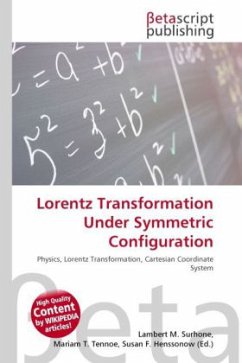High Quality Content by WIKIPEDIA articles! In physics, the Lorentz transformation converts between two different observers' measurements of space and time, where one observer is in constant motion with respect to the other. Assume there are two observers O1 and O2, each using their own Cartesian coordinate system to measure space and time intervals. O1 uses (t1,x1,y1,z1) and O2 uses (t2,x2,y2,z2). Assume further that the coordinate systems are oriented so that the x1-axis and the x2-axis overlap but in opposite directions. The y1-axis is parallel to the y2-axis but in opposite directions. The z1-axis is parallel to the z2-axis and in the same direction. The relative velocity between the two observers is v along the x1 or x2 axis. v is defined as a positive number when O1 sees O2 sliding in the direction of x1. Also assume that the origins of both coordinate systems are the same. If all this holds, then the coordinate systems are said to be in symmetric configuration.








